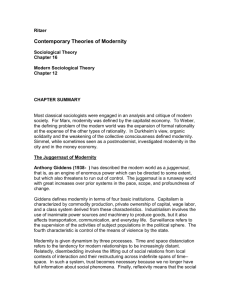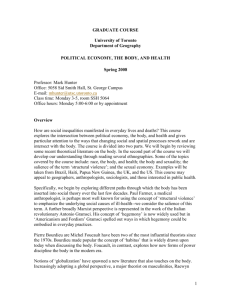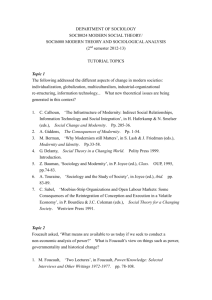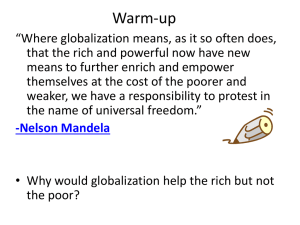Sociology 302 Final Outline
advertisement
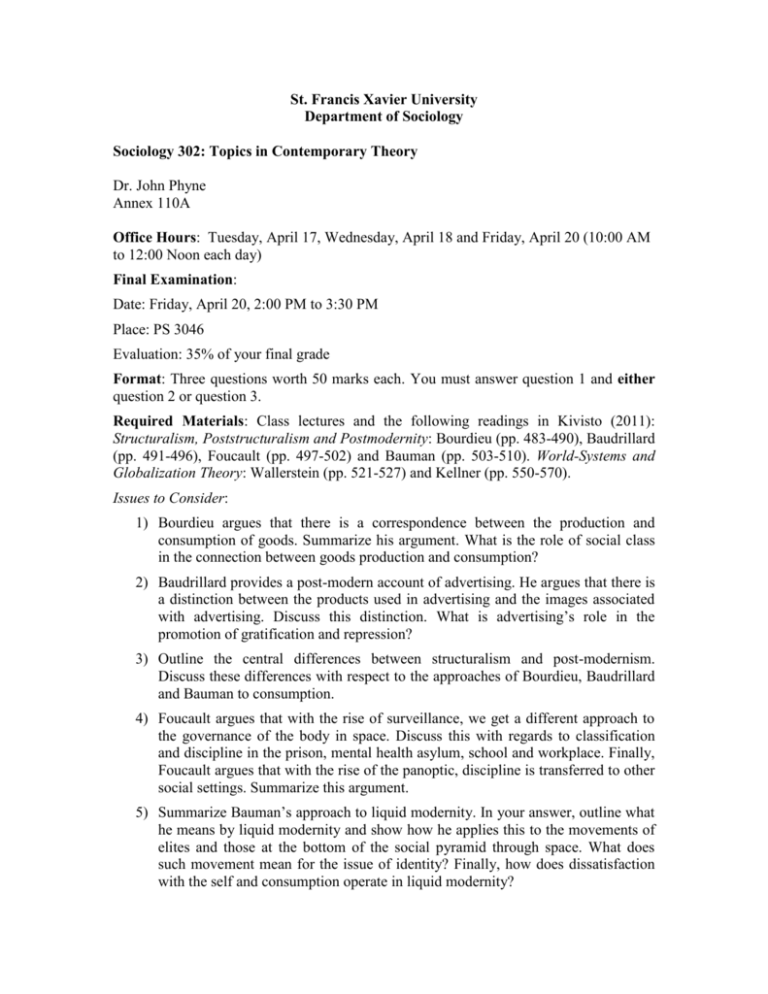
St. Francis Xavier University Department of Sociology Sociology 302: Topics in Contemporary Theory Dr. John Phyne Annex 110A Office Hours: Tuesday, April 17, Wednesday, April 18 and Friday, April 20 (10:00 AM to 12:00 Noon each day) Final Examination: Date: Friday, April 20, 2:00 PM to 3:30 PM Place: PS 3046 Evaluation: 35% of your final grade Format: Three questions worth 50 marks each. You must answer question 1 and either question 2 or question 3. Required Materials: Class lectures and the following readings in Kivisto (2011): Structuralism, Poststructuralism and Postmodernity: Bourdieu (pp. 483-490), Baudrillard (pp. 491-496), Foucault (pp. 497-502) and Bauman (pp. 503-510). World-Systems and Globalization Theory: Wallerstein (pp. 521-527) and Kellner (pp. 550-570). Issues to Consider: 1) Bourdieu argues that there is a correspondence between the production and consumption of goods. Summarize his argument. What is the role of social class in the connection between goods production and consumption? 2) Baudrillard provides a post-modern account of advertising. He argues that there is a distinction between the products used in advertising and the images associated with advertising. Discuss this distinction. What is advertising’s role in the promotion of gratification and repression? 3) Outline the central differences between structuralism and post-modernism. Discuss these differences with respect to the approaches of Bourdieu, Baudrillard and Bauman to consumption. 4) Foucault argues that with the rise of surveillance, we get a different approach to the governance of the body in space. Discuss this with regards to classification and discipline in the prison, mental health asylum, school and workplace. Finally, Foucault argues that with the rise of the panoptic, discipline is transferred to other social settings. Summarize this argument. 5) Summarize Bauman’s approach to liquid modernity. In your answer, outline what he means by liquid modernity and show how he applies this to the movements of elites and those at the bottom of the social pyramid through space. What does such movement mean for the issue of identity? Finally, how does dissatisfaction with the self and consumption operate in liquid modernity? 2 6) Globalization is not new; it has existed for over 500 years. Discuss with regards to Wallerstein’s approach to hegemony in the capitalist world economy. In your answer, summarize the factors he associates with hegemony, and the three instances of hegemony that have operated for the 500 years leading up to 1980. Finally, what does Wallerstein mean by core-periphery relations? 7) What are core-periphery relations? How does this relate to unequal exchange? Finally, discuss core-periphery relations within the context of global commodity chains. 8) Kellner argues that globalization “… is imposed from above and yet can be contested and reconfigured from below”. Discuss with reference to the role played by technology and the restructuring of capitalism in globalization, and the role of technology in the operation of global social movements.

